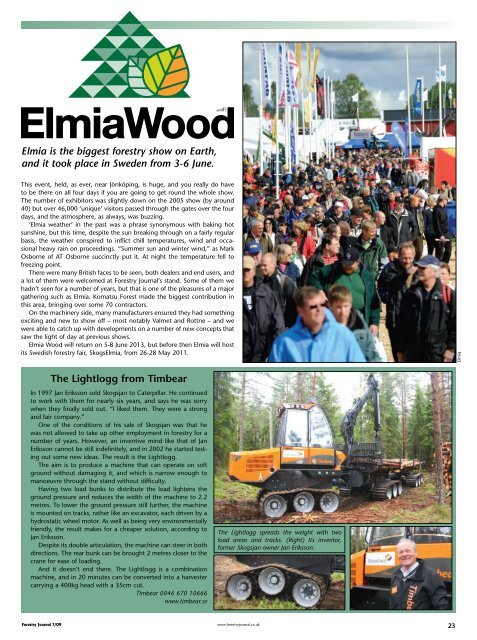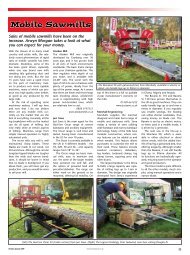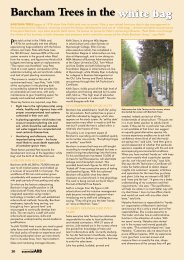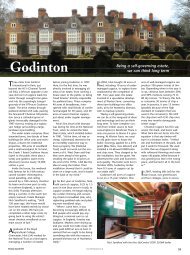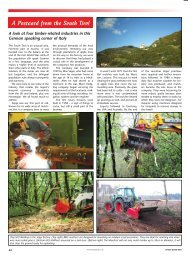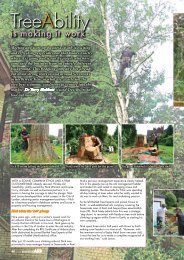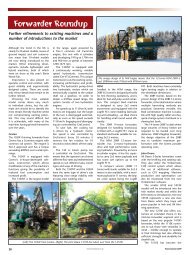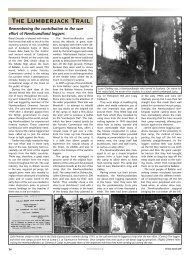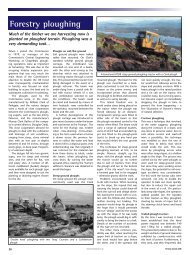Elmia Wood 2009 - Forestry Journal
Elmia Wood 2009 - Forestry Journal
Elmia Wood 2009 - Forestry Journal
Create successful ePaper yourself
Turn your PDF publications into a flip-book with our unique Google optimized e-Paper software.
<strong>Elmia</strong> is the biggest forestry show on Earth,<br />
and it took place in Sweden from 3-6 June.<br />
This event, held, as ever, near Jönköping, is huge, and you really do have<br />
to be there on all four days if you are going to get round the whole show.<br />
The number of exhibitors was slightly down on the 2005 show (by around<br />
40) but over 46,000 ‘unique’ visitors passed through the gates over the four<br />
days, and the atmosphere, as always, was buzzing.<br />
‘<strong>Elmia</strong> weather’ in the past was a phrase synonymous with baking hot<br />
sunshine, but this time, despite the sun breaking through on a fairly regular<br />
basis, the weather conspired to inflict chill temperatures, wind and occasional<br />
heavy rain on proceedings. “Summer sun and winter wind,” as Mark<br />
Osborne of AT Osborne succinctly put it. At night the temperature fell to<br />
freezing point.<br />
There were many British faces to be seen, both dealers and end users, and<br />
a lot of them were welcomed at <strong>Forestry</strong> <strong>Journal</strong>’s stand. Some of them we<br />
hadn’t seen for a number of years, but that is one of the pleasures of a major<br />
gathering such as <strong>Elmia</strong>. Komatsu Forest made the biggest contribution in<br />
this area, bringing over some 70 contractors.<br />
On the machinery side, many manufacturers ensured they had something<br />
exciting and new to show off – most notably Valmet and Rottne – and we<br />
were able to catch up with developments on a number of new concepts that<br />
saw the light of day at previous shows.<br />
<strong>Elmia</strong> <strong>Wood</strong> will return on 5-8 June 2013, but before then <strong>Elmia</strong> will host<br />
its Swedish forestry fair, Skogs<strong>Elmia</strong>, from 26-28 May 2011.<br />
<strong>Elmia</strong><br />
The Lightlogg from Timbear<br />
In 1997 Jan Eriksson sold Skogsjan to Caterpillar. He continued<br />
to work with them for nearly six years, and says he was sorry<br />
when they finally sold out. “I liked them. They were a strong<br />
and fair company.”<br />
One of the conditions of his sale of Skogsjan was that he<br />
was not allowed to take up other employment in forestry for a<br />
number of years. However, an inventive mind like that of Jan<br />
Eriksson cannot be still indefinitely, and in 2002 he started testing<br />
out some new ideas. The result is the Lightlogg.<br />
The aim is to produce a machine that can operate on soft<br />
ground without damaging it, and which is narrow enough to<br />
manoeuvre through the stand without difficulty.<br />
Having two load bunks to distribute the load lightens the<br />
ground pressure and reduces the width of the machine to 2.2<br />
metres. To lower the ground pressure still further, the machine<br />
is mounted on tracks, rather like an excavator, each driven by a<br />
hydrostatic wheel motor. As well as being very environmentally<br />
friendly, the result makes for a cheaper solution, according to<br />
Jan Eriksson.<br />
Despite its double articulation, the machine can steer in both<br />
directions. The rear bunk can be brought 2 metres closer to the<br />
crane for ease of loading.<br />
And it doesn’t end there. The Lightlogg is a combination<br />
machine, and in 20 minutes can be converted into a harvester<br />
carrying a 400kg head with a 35cm cut.<br />
Timbear 0046 670 10666<br />
www.timbear.se<br />
The Lightlogg spreads the weight with two<br />
load areas and tracks. (Right) Its inventor,<br />
former Skogsjan owner Jan Eriksson.<br />
<strong>Forestry</strong> <strong>Journal</strong> 7/09 www.forestryjournal.co.uk<br />
23
John Deere<br />
The John Deere 1910E forwarder has a 9 litre engine and a CF8 loader.<br />
John Deere <strong>Forestry</strong> had its complete E series on display for the first time,<br />
including the 810E, 1010E and 1910E forwarders.<br />
They also introduced TimberLink F software which enables forwarder<br />
operators to monitor and optimise machine performance.<br />
Taking a leaf out of Volvo’s book, Deere are developing a hybrid drive<br />
train. Instead of powering the axles through a torque converter, this uses a<br />
smaller than normal diesel engine which drives a generator, then a motor<br />
followed by a two-speed gearbox. A traditional mechanical transmission is<br />
eliminated, because the variable speed electric motor takes the function of<br />
a continuously variable transmission. Despite a reduction in diesel engine<br />
power, the system is fully capable of accomplishing the same work as a<br />
conventional drive train. Additionally, it can recover brake energy and provide<br />
power boost for peak load situations. Depending on the application,<br />
electrification can enhance fuel efficiency by 15-25%.<br />
John Deere <strong>Forestry</strong> 0870 224 3745<br />
www.e-series.fi<br />
Stepless HSM<br />
HSM were showing off their 805F forwarder that can be converted, by<br />
means of a quick change system, into a clambunk. The machine is also<br />
equipped with a double drum Adler winch with two times 8 tonnes pulling<br />
capacity. New is the Mercedes 174hp/129kW OM904LA engine replacing<br />
the 141hp Iveco.<br />
Of special interest was the machine’s ICVD (Integrated Continuously<br />
Variable Drive), a system developed by Walterscheid GKN. There was a<br />
cutaway version of this on the stand to show how it works. It is based on<br />
the bent axis 45° technology which was first introduced into the market<br />
with the Fendt Vario transmission. This system was made exclusively for<br />
Fendt by Sauer Danfoss for 10 years, but has been openly available for the<br />
last three years.<br />
It makes it possible to drive faster without diminishing tractive force,<br />
and to accelerate through the entire speed range without interrupting the<br />
drive.<br />
Forest Technical Ltd 07814 393810<br />
http://hsm-forstmaschinen.de<br />
The modus operandi of the<br />
Beast. It is operated remotely<br />
from the cabs of two or more<br />
forwarders, each forwarder<br />
taking over control when the<br />
other(s) are travelling and<br />
unloading.<br />
The Beast turns green<br />
At the last <strong>Elmia</strong> <strong>Wood</strong> we were introduced to the Beast and its messengers.<br />
This unmanned harvester, operated from the forwarders which it<br />
loaded direct from its felling head, was on the Rottne stand, and sported<br />
a Rottne head.<br />
The concept has now been taken over by Gremo, who will continue<br />
developing it in cooperation with Swedish forestry collective and management<br />
company Södra, who have bought a Beast.<br />
The system brings a number of advantages over the conventional<br />
approach. Trees are logged directly onto the revolving load bays of the<br />
forwarders, saving double handling, and, with no harvester driver, there<br />
is a saving in labour.<br />
Gremo are also developing a version of the Beast that is suited to stump<br />
harvesting.<br />
Gremo 0046 346 60515 – www.gremo.com<br />
24<br />
www.forestryjournal.co.uk<br />
<strong>Forestry</strong> <strong>Journal</strong> 7/09
Ponsse’s new 8-wheel thinning harvester, the Fox.<br />
Ponsse<br />
Ponsse had their new, 8-wheel thinning harvester on display, the Fox.<br />
With a width of 2.64 to 2.84 metres, depending on tyre size, it is fitted<br />
with new type of crane, the C22, which has a reach of 11 metres. This<br />
has been moved nearer the cab than on other models, which, Ponsse<br />
say, gives better visibility and optimal weight distribution. It is powered<br />
by a 197hp, four-cylinder Mercedes-Benz engine. The harvester weighs<br />
18 tonnes and carries an H53e head.<br />
Ponsse’s well proven Ergo harvester is also now available in an eightwheel<br />
version, which also has a 12% increase in tractive force.<br />
Ponsse have also produced a new medium-sized, general purpose<br />
harvester head, the H6. With three feed rollers and two fixed plus four<br />
movable knives, it has a felling diameter of 640mm and can be used on<br />
thinnings and clearfells. Weight is just over a tonne. The H6 can also be<br />
equipped with the multi-stemming feature, which makes harvesting of<br />
small timber faster. This feature is now also available on Ponsse’s H53e<br />
and H7 heads and is aimed principally at energy wood harvesting.<br />
Ponsse 01576 203000<br />
www.ponsse.com<br />
Valmet<br />
Valmet had a wide array of new products to show off on their stand –<br />
two new harvesters, a new forwarder and three new heads.<br />
We got a sneak preview of the two harvesters in the June edition.<br />
The 931 weighs just under 20 tonnes and has a 9.4 litre, 6-cylinder<br />
commonrail engine. The CRH22 crane is available in two lengths – 8.5<br />
metres (for use with the 370.2 head) and 9.8 metres (for use with 360.2<br />
and 365 heads).<br />
The 901TX (‘Thinning Xpert’) is a 17 tonne harvester with two crane<br />
options, the 10 metre CHR16, for use with the 350.1 head, and the 11<br />
metre CRH16DT. Gross lifting torque is particularly high at 170 kNm.<br />
Both new harvesters are fitted with Valmet Comfort bogies and come<br />
with the latest 1.4 version of the MaxiXplorer control system.<br />
To work alongside the 901TX, Valmet have introduced the 840TX<br />
8-wheel forwarder. Designed for agility in thinnings, it has a short<br />
rear frame and nose, giving it an overall length of 9.02 metres, as<br />
against 9.57 metres for a standard 840.4. Weight is also less, by 800kg,<br />
although carrying capacity remains unchanged at 12 tonnes.<br />
The 365 is a new harvester head with a delimbing diameter of<br />
470mm. With three feed rollers, it has four fixed and one movable<br />
knife, and a new, patented measuring system. It takes its place in the<br />
Valmet head line-up along with the new 378, which is designed for use<br />
on excavators of 20 tons or more. It will delimb up to 500mm.<br />
Finally Valmet have introduced the world’s first fully rotating head,<br />
the 370E, which is able to go round and round without breaking the<br />
hoses. It is designed principally for use with tracked feller bunchers and<br />
excavators. Komatsu Forest 01228 792018<br />
www.komatsuforest.com<br />
<strong>Elmia</strong><br />
Whole trees to pellets<br />
The Peterson 5900 whole tree chipper caused<br />
quite a stir in the biomass area. According to the<br />
American manufacturer, it produces chips as small<br />
as 6mm in length. This is the ideal raw material for<br />
pellet plants and the pulp industry. A complete<br />
system incorporating the 4800 debarker was on<br />
show. The chipper takes stems up to 56cm in<br />
diameter.<br />
The standard version, with a 168mm disk and<br />
three knives, produces chips between 16 and<br />
32mm in length. A four knife version is available<br />
with two disk diameters. Production capacity<br />
ranges from 55 to 90 tonnes an hour, depending<br />
on the type of timber, its diameter and the<br />
required chip length.<br />
The 5900 is powered by a 765hp Cat diesel<br />
engine and weighs just under 20 tonnes.<br />
Peterson 001 541 689 6520<br />
http://petersonpacific.com<br />
<strong>Forestry</strong> <strong>Journal</strong> 7/09 www.forestryjournal.co.uk<br />
25
Tigercat 1075B with extendable bunks and a very large load.<br />
Tigercat<br />
Tigercat displayed harvesting and biomass systems as well as a skidder<br />
and forwarder based scarifiers at <strong>Elmia</strong> <strong>Wood</strong><br />
Tigercat are known in the UK for their tracked harvesters, and their<br />
LH845C track-based levelling harvester attracted much attention, not<br />
from Swedish visitors, where operations are almost exclusively cut-tolength,<br />
but from UK, German, Russian and Norwegian customers where<br />
the negotiation of steep slopes is an everyday event.<br />
The stand also featured the narrow (1.9m on 400/55x22.5 tyres),<br />
eight-wheel drive H09 harvester, which Tigercat say is popular throughout<br />
Sweden, and there was also a 1075B forwarder with extended bunks,<br />
stacked with a very impressive load. The 20-tonne rated machine has<br />
wide bogie axles, a massive centre joint, a new cab and new MD3 control<br />
display.<br />
Tigercat also demonstrated a 1055B 14-tonne forwarder which was put<br />
through its paces over the four days. There was also an additional 1055B<br />
equipped with a Bruks mobile chipper mounted on it.<br />
There were also machines for mechanised site preparation and planting.<br />
The Tigercat 635D with the its Turnaround seat has gained favour in<br />
Swedish scarifying applications as a rugged, low cost carrier compared<br />
with a traditional forwarder. Various types of site preparation implements<br />
can be mounted onto the six-wheel drive, hydrostatically driven carrier.<br />
Tigercat also put a 1075 forwarder with a large four row Bracke scarifier<br />
on the Bracke stand.<br />
Treetop <strong>Forestry</strong> 07768 613036 – www.tigercat.com<br />
Volvo<br />
Volvo’s aim is to be a ‘total solutions provider’ covering many segments,<br />
including forestry, according to Jukka Moisander, Volvo’s<br />
Director of Global <strong>Forestry</strong> Solutions.<br />
When briefing journalists he noted that tree length harvesting<br />
still accounts for two thirds of the volume cut around the world,<br />
with cut-to-length accounting for the other third, though its share is<br />
growing.<br />
But Volvo’s target is to cover everything, including harvesting,<br />
transport to the mill, handling at the mill, and replanting. And on<br />
top of that you can add bioenergy harvesting, including stumps, and<br />
road maintenance.<br />
At present the only harvesters in the Volvo range run on tracks.<br />
There are four of them, ranging from 21 to 33 tonnes in weight, two<br />
of them fitted with Volvo’s LevelMax system. Other features include<br />
a gull-wing hood design – strong enough to withstand a tree falling<br />
on it.<br />
“But we need a forwarder in our product offering,” continued<br />
Jukka Moisander. With this in mind, Volvo has bought up the rights<br />
to the El-Forest diesel-electric 15 tonne forwarder which was first<br />
glimpsed at the previous <strong>Elmia</strong> <strong>Wood</strong> in 2005. This is powered by a<br />
small (80hp) diesel engine which drives a generator which charges<br />
14 12-volt batteries. With two of these used to power engine start-up<br />
and lights, the remaining 12 drive AC motors in each of the six wheels<br />
of the forwarder. Each of these has an output of 30kW, giving a possible<br />
tractive force of 294kN, though in practice this has been tuned<br />
down to around 200kN since that is all that is really needed.<br />
The speed of each wheel is individually controlled, and the sixwheel<br />
design is such that the wheels follow the same track. The<br />
El-Forest has half the turning radius of a conventional forwarder, and<br />
the machine’s design, and the fact that the air conditioning unit is<br />
housed outside the continuously rotating cab, mean the noise level is<br />
exceptionally low.<br />
The pendulum axle at the front gives side levelling, and the absence<br />
of traditional bogie axles make the machine lighter than a traditional<br />
forwarder. In principle it is a fifteen tonner with a 1:1 carrying capacity,<br />
although the design could be simply scaled up in size.<br />
The El-Forest is at the pre-series stage at the moment, and should<br />
go into full serial production in 2010. Volvo 01223 836636<br />
www.volvo.com – www.el-forest.se<br />
(Above) Volvo’s hybrid drive F15 forwarder. (Below) It’s electric, and the lack of<br />
conventional bogies, each wheel being driven by its own electric motor, makes<br />
the El-Forest lighter than a normal machine of similar capacity.<br />
26<br />
www.forestryjournal.co.uk<br />
<strong>Forestry</strong> <strong>Journal</strong> 7/09
Logset<br />
Shaun Harper of Logset Ltd and Pasi Nieminen, Sales Director<br />
of Oy Logset Ab, with the 5L head which is now capable of<br />
efficient multi-stem handling.<br />
The emphasis on the Logset stand was on fuel economy. Agco Sisu Power has developed<br />
customised engine software for Logset to meet the demands of forest machines.<br />
The software, together with Logset’s TOC (Total Operator Control) system, optimises<br />
fuel injection in accordance with the prevailing load and the required level of hydraulic<br />
pressure and oil flow. The engine responds to changing conditions quickly to balance<br />
power, torque and engine revs.<br />
On display on the stand were testimonies from various contractors, including a<br />
couple from Britain, as to the effectiveness of the system. Ron Drennan was quoted as<br />
saying, “My machine is very reliable and easy to run. Fuel consumption is very good.<br />
The machine is very stable and comfortable to operate.” He has apparently been using<br />
9 litres an hour on his 8F forwarder, which weighs 17 tonnes and has a load capacity<br />
of 15 tonnes.<br />
Des Pickard, who was pictured beside his 8H harvester, simply said: “I am absolutely<br />
delighted with the low fuel consumption.” The figure quoted was 0.7 litres per tonne<br />
harvested.<br />
Oy Logset Ab is part of the giant Pilomac Group, which had a turnover of some<br />
e100 million last year.<br />
Logset Ltd 01228 792500<br />
www.logset.com<br />
Throw Saw<br />
The throw saw consists of a 45 metre line with a length of saw chain in the middle. The line is<br />
supplied with a throw bag to enable the line to be thrown over high branches. Once the saw<br />
chain is positioned over the part of the tree that is to be cut, work can commence, two people<br />
pulling the saw chain backwards and forwards until the tree is cut. A weight on the chain keeps<br />
it the right way up so that the teeth locate correctly into the cut.<br />
Although it is very low-tech, the throw saw does have one big advantage over chainsaws: it is<br />
able to cut through timber that is under pressure. This occurs, for instance, if a stem is not lying<br />
completely on the ground, but has its weight supported at either end and not in the middle.<br />
(For instance, this would be the case if, in the picture shown, the cut were being made to the<br />
left of the trestle support.)<br />
When this is the case, as long as the diameter of the timber is greater than 4 to 6 inches, the<br />
throw saw will cut through it from the top without difficulty. A chainsaw, on the other hand, with<br />
its wide bar, will get stuck as the cut closes together under gravity.<br />
The line that holds the throw saw is certified for working under electrical lines.<br />
Throw Saw 0046 733 926105<br />
www.throw-saw.com<br />
Reinventing the grapple<br />
Notice something odd about the grapple in the picture Hultdins have<br />
broken with tradition and come up with a new design which, they say,<br />
gives faster loading and unloading of logs.<br />
It all began with problems using a grapple saw to handle and cut brash<br />
for biofuel. Because brash invariably lies strewn in a chaotic fashion, the<br />
grapple saw was finding it hard to pick up cleanly. A long serving member<br />
of Hultdins’ staff suggested a solution – a grapple with modified jaws.<br />
Although it seemed something of a long shot, the company decided to<br />
make one anyway and see if it worked.<br />
It did. The brash now formed into a well aligned sausage shape in the<br />
grapple. However, the unexpected bonus was that the new grapple also<br />
performed much better on logs as well. Initial studies made by Swedish<br />
research institute Skogforsk indicate that forwarder loading is 4-5% faster<br />
and unloading 7-8% faster with the ‘A-Grapple’, as it is known, compared<br />
to a standard grapple. Its asymmetrical shape makes it easier to pick up<br />
single logs and to organise the log pile. It also simplifies work in hilly terrain<br />
and the picking up of leaning logs.<br />
The arms of the A-Grapple improve the way the logs roll into the grapple.<br />
With conventional jaws there is always a risk that a piece of wood gets<br />
clamped between them, obstructing the closing motion of the grapple.<br />
The angled ends on the A-Grapple feed everything that the tips can grab<br />
into the grapple, and the rest is fed out. Nothing can get stuck between<br />
the grapple arms and the closing motion of the grapple is unimpeded.<br />
The tips of<br />
the A-Grapple<br />
have minimal<br />
contact<br />
surface to<br />
the ground,<br />
so bringing<br />
much less dirt<br />
and sand with<br />
them than<br />
on a normal<br />
grapple.<br />
And, of<br />
course, when<br />
working on<br />
brash, since<br />
the arms feed<br />
it either into<br />
or out of the<br />
grapple, the<br />
branches are well aligned with every grab. The density of the load is<br />
increased and brash piles become better organised.<br />
Hultdins 0046 953 41800 – www.hultdins.se<br />
Vielen Dank Dieter Biernath!<br />
<strong>Forestry</strong> <strong>Journal</strong> 7/09 www.forestryjournal.co.uk<br />
27
No more chain oil on harvesters<br />
In future, chain oil could be no longer necessary in harvester heads.<br />
Instead lubrication could be carried out using grease.<br />
This brings many advantages. Consumption can be reduced by a<br />
factor of 12 – ie 12 times more chain oil than grease is needed to do<br />
the same job. On top of this, the chain and bar are expected to last<br />
much longer. This all adds up to less pollution and a great reduction in<br />
operating costs.<br />
These are the claims of Canadian company STL Lubrifiants for their<br />
Envirosys system, which they say works with all harvesting heads. Their<br />
figures – namely that 2kg of grease is equivalent to 24 litres of oil –<br />
have been verified by Feric (The Forest Engineering Research Institute<br />
of Canada) in both summer and winter conditions over a period of 12<br />
months.<br />
Grease is supplied on demand according to what has been programmed<br />
into the system’s electrical control unit. The reason for such<br />
a marked improvement in performance is down to grease’s properties<br />
compared to those of oil. Grease has better consistency, adhesiveness<br />
and film strength. 80% of chain oil either evaporates or is flung off.<br />
The biodegradable grease used in the system is supplied in accordion-type<br />
cartridges which can be replaced in a few seconds. There is no<br />
need to go near the head to replenish the reservoir. Instead the reservoir<br />
and pump are installed near the operator’s cabin. Experience in Sweden<br />
has shown that one cartridge will last about a week.<br />
STL Lubrifiants 001 418 275 5282 – www.envirosysforest.com<br />
Mini harvester<br />
Vimek is expanding. In 2004 its turnover was e2 million. Last year this<br />
had risen to e5.5 million. And the product range has been expanding<br />
too. Well known for its mini forwarder, the company has now added a<br />
mini harvester, the 404 T3, to its range.<br />
Development began in 2004/5. The machine had no harvester head,<br />
instead using a shear for early thinnings. Clearing trees under power<br />
lines had been the idea, but no market could be found for the machine.<br />
The machine was therefore redesigned, and the 404 T was the result.<br />
This stayed in production until very recently, with the upgraded T3<br />
now taking over. This carries a Keto head, designed in a collaboration<br />
between the two companies. The head has a new type of tilt frame, a<br />
conventional rotator, and a new, patent pending swing damper.<br />
The new harvester has also meant that Vimek have had to design<br />
a new forwarder, since its well proven 606, which was developed in<br />
1992, is not able to keep up with it. The 606 will remain in production,<br />
but, at 4.5 tonnes, the new 608’s load capacity is 50% higher than its<br />
predecessor’s. The 608 has a new trailer and a longer crane, but is only<br />
10cm wider overall. A swing damper has been added as an option as<br />
well as a tilt grapple to assist loading in thinnings.<br />
Vimek have also produced the BioCombi, a forwarder with a felling<br />
grapple that cuts stems up to 16cm with a shear. It is intended for use<br />
gathering biofuel material. The machine is equipped with a weighing<br />
scale and can apply stump treatment. Vimek 0046 933 71075<br />
www.vimek.se<br />
Instant firewood<br />
Nokka’s Klapimoto turns trees into firewood, cutting out all the stages in<br />
between. Of course, the wood still needs to be seasoned, but Nokka offer<br />
a trailer with removable containers into which the freshly cut wood is<br />
dropped. All that remains is to put these somewhere dry, and wait.<br />
The Klapimoto 23 is basically a light stroke harvesting head which<br />
forces stems up to 23cm in diameter through a splitting knife, using a<br />
guillotine to cut them into lengths from 20 to 52cm. Delimbing diameter<br />
is 6 to 23cm and delimbing/splitting force is 3.4 tonnes.<br />
Oil requirement is 30 to 60 lpm at 175 bar, and the maximum stroke<br />
length is 75cm. All functions are operated by the loader’s control valve<br />
block and via a touchscreen and pre-select electrical control box.<br />
Nokka 00358 14 3301 500 – http://nokka.fi<br />
28<br />
www.forestryjournal.co.uk<br />
<strong>Forestry</strong> <strong>Journal</strong> 7/09
Chain brushcutter<br />
Quantifying chip<br />
Austrian chipper manufacturer Mus-Max had a scanner on the<br />
elevator of their Terminator 10 chipper. The technology is borrowed<br />
from sawmilling and is used to quantify the production<br />
of the machine. Using this approach it is possible to work out<br />
the volume of chip produced within a margin of error of 1%.<br />
The Terminator 10 has a 700hp engine and can produce<br />
300 cubic metres of chips an hour.<br />
Also on display was the T9 XL for tractors of 200 to 300hp.<br />
This has an infeed of 70cm high by 82cm wide.<br />
Eurogreen 01903 700678 – www.mus-max.at<br />
Bengt-Åke Alriksson spends<br />
a lot of his time wielding a<br />
brushcutter.<br />
Like many charged with this<br />
task, he found himself thinking,<br />
“There must be an easier way.”<br />
And he set about redesigning<br />
the brushcutter to make the<br />
work easier, more comfortable,<br />
and more accurate.<br />
Gone is the circular cutter,<br />
replaced by a small chainsaw.<br />
This alone brings many benefits<br />
– it can be manoeuvred<br />
with greater precision, and,<br />
as it finishes cutting through<br />
a stem, it does not accelerate and move suddenly into the next one, or into a<br />
stone.<br />
Another change to the design is that the control handles have been eliminated,<br />
making the brushcutter easier to lift and carry through dense undergrowth.<br />
It is quite common in Sweden to use a brushcutter to clear regenerated birch<br />
or Scots pine. “The new design means I can use it as a weapon,” said Bengt-Åke<br />
Alriksson. He used to be a long distance canoeist, and studied the ergonomics<br />
of brushcutting, differentiating between static and dynamic muscle work. The<br />
brushcutter’s engine is held on a harness behind the user with the weight supported<br />
by the hips. Tension in the shoulders is eliminated, and the user can relax,<br />
even though, at 13kg, the brushcutter is slightly heavier than normal. The weight<br />
is well distributed, and extensive studies have shown that the user’s pulse rate is<br />
10% lower than that of someone using a conventional brushcutter. Work is assisted<br />
by the machine’s longer reach, meaning the user can stand on good ground and<br />
save a lot of steps.<br />
Bengt-Åke Alriksson finds it easy to work all day long with the brushcutter. “You<br />
shouldn’t need to be an athlete to do a day’s work,” he says. “Amateurs and pensioners<br />
can do this too.”<br />
Readers with long memories may remember reading about this machine, then<br />
at the development stage, in FMJ’s Skogs<strong>Elmia</strong> roundup of two years ago. At the<br />
time it was anticipated that the chain brushcutter would be in stores at the end of<br />
2008. This date has now been revised to the first quarter of next year, with production<br />
commencing this autumn. Husqvarna 01453 820300<br />
Silly outfits<br />
One way to get noticed at a huge event like <strong>Elmia</strong><br />
is to make an exhibition of yourself, and that is<br />
just what the girls from Svenska Skogsplantor,<br />
and the boys from MES-Smide did.<br />
Svenska Skogsplantor were running a quiz<br />
with the chance to win 1000 seedlings. Based in<br />
Hallsberg, they are one of the largest European<br />
companies specialising in seeds, bare root<br />
and container seedlings, and afforestation. As<br />
you can see, they offer healthy, happy young<br />
plants.<br />
MES-Smide is a small scale operation making<br />
bandtracks, and they had travelled 1000<br />
kilometres south from Bredbyn to be at the<br />
show, where they wore the same outfits as the<br />
womenfolk on their stand. “It is a kilt!” we were<br />
told, as if that explained everything. There is no<br />
tradition of kilt wearing in Sweden, as far as we<br />
can make out, but maybe we haven’t looked in<br />
the right places.<br />
MES specialises in smaller bandtracks, the<br />
market for larger ones being largely saturated.<br />
www.skogsplantor.se<br />
http://messmide.se<br />
The girls from Svenska Skogsplantor (left) and the boys<br />
from Markus Edlunds Svets och Smide (Markus Edlund’s<br />
Welding and Forging).<br />
<strong>Forestry</strong> <strong>Journal</strong> 7/09 www.forestryjournal.co.uk<br />
29
Green Gator Eyes<br />
Bright future<br />
for LED lights<br />
Hella were showing off their LED<br />
(light emitting diode) lights, which<br />
they anticipate being used as work<br />
lights on harvesters and forwarders.<br />
They are also finding their way onto<br />
cars – for instance they are already<br />
available as brake lights on the VW<br />
Tiguan.<br />
LED lights have many advantages<br />
over conventional lights: they use<br />
50% less energy, are robust, and have<br />
a life span up to 130 times greater<br />
than a halogen bulb.<br />
So, you want to measure the diameter of that tree<br />
over there, just the other side of the stream. Or<br />
perhaps you’d like to know its diameter 20 feet up,<br />
but no way are you climbing all the way up there<br />
to find out.<br />
The answer’s simple with Gator Eyes, the laser<br />
add-on for calipers from Haglöf, and, to make things<br />
even easier, if it’s a digital Haglöf caliper you are<br />
using, the result can be recorded at the touch of a<br />
button.<br />
This isn’t entirely new technology, but the eyes<br />
are now available in green. There was a problem<br />
using the red Gator Eyes on a sunny day, but the<br />
green eyes are 50 times brighter, and so remain visible<br />
in areas of bright light.<br />
Sorbus International 01373 475540<br />
www.sorbus-intl.co.uk<br />
(Above) The<br />
SSP 520 in<br />
action. (Far<br />
left) A change<br />
in length of<br />
the cut billets<br />
could not be<br />
easier – just<br />
move the pin.<br />
(Left) The<br />
saw, more<br />
usual in a<br />
harvester<br />
head.<br />
Binderberger<br />
Binderberger have produced a<br />
bigger version of their firewood<br />
processor for use on large timber.<br />
The SSP 520 has a 20 tonne<br />
splitting force, and will take logs<br />
52cm in diameter. It weighs 4<br />
tonnes.<br />
Its 50hp German made Hatz<br />
diesel engine uses 4 litres of fuel<br />
an hour – half what a pto tractor<br />
would consume if performing<br />
the same task, according to<br />
Binderberger.<br />
The processor uses a harvester<br />
head style saw unit with<br />
automatic chain tensioning and<br />
lubrication – the first time this<br />
has been done on a firewood<br />
processor.<br />
When used in fully automatic<br />
mode, the machine can be operated<br />
by just one person.<br />
Although brand new, 20<br />
examples of the SSP 520 have<br />
been sold already, close to<br />
Binderberger’s factory in Austria.<br />
1000 of the smaller firewood<br />
processor, the SSP 450, have<br />
been sold over the last 10 years.<br />
Marshall Agricultural Engineering<br />
01892 770788<br />
or 07836 274164<br />
www.marshalllogging.co.uk<br />
30<br />
www.forestryjournal.co.uk<br />
<strong>Forestry</strong> <strong>Journal</strong> 7/09
The smaller of the chainsaw winches, the VIK<br />
615, with the side cover removed (below) to<br />
show how the chainsaw attaches.<br />
Chip and shred<br />
Jenz were showing off their new<br />
BA 720 chipper/shredder, which<br />
replaces the AZ 660 in their<br />
line-up.<br />
This is a biomass processor,<br />
with an infeed of 720 by<br />
1500mm. The rotor speed can<br />
be varied, and the operator can<br />
select the optimum speed for the<br />
work in hand. Chipping operations<br />
require a speed of 400rpm,<br />
whilst shredding work needs<br />
1000rpm.<br />
The machine’s ‘Easygreen’<br />
controller monitors the its operation<br />
and also provides service<br />
data, such as operating hours,<br />
fuel consumption and engine<br />
performance. As an option, the<br />
quantity of chip produced can<br />
also be measured.<br />
The machine’s ‘Vario-Flex’<br />
controller makes it easy to select<br />
the optimum rotation speed for<br />
the material being processed,<br />
resulting in fuel consumption as<br />
low as 0.3 litres per cubic metre.<br />
Westcon Eqpt 01258 859100<br />
www.westconuk.co.uk<br />
Able to process everything, including garden waste, bark<br />
and timber, the Jenz BA 720 can operate either as a biomass<br />
chipper or as a shredder by simply changing the speed of the<br />
rotor (below).<br />
Chainsaw winch<br />
Now here’s a handy idea: you can use your<br />
chainsaw to power this winch.<br />
The manufacturer of this item is Austrian<br />
company Interforst – not to be confused with<br />
the German forestry show of the same name.<br />
They make two models, details of which are<br />
below… simply replace your bar and chain with<br />
the winch and start pulling in the timber.<br />
They work with most makes of chainsaw,<br />
making a portable solution that can be carried<br />
easily in both your vehicle and into the forest.<br />
Interforst do not have a British dealer, and if<br />
you go onto their website, clicking the Union<br />
Jack makes no difference to the language – it’s<br />
still all in German. To find the items, put the letters<br />
‘VIK’ in the search (‘Suche’) box.<br />
The winches are not particularly cheap, given<br />
the current level of the pound against the euro:<br />
the VIK 615 costs €1,690 including a Jonsered<br />
or Husqvarna chainsaw but without rope. The<br />
VIK 1000 costs €1,550 without accessories.<br />
Interforst 0043 3577 25700<br />
http://www.interforst.at<br />
Email office@interforst.at<br />
Model VIK 615 VIK 1000<br />
Max. Pull 600kg 1.2 tonnes<br />
Chainsaw Power 2.7 to 4 hp 4 hp<br />
Rope 55m x 4.5mm 80m x 6.5mm<br />
120m x 3mm 120m x 5mm<br />
Weight without saw 17 kg 27 kg<br />
Total weight 27 kg 42 kg<br />
Infeed speed 21 m/min 28 m/min<br />
Rottne<br />
Rottne used <strong>Elmia</strong> <strong>Wood</strong> to present their new F15 forwarder. This will replace the Solid F14. It<br />
has the same payload as its predecessor but higher performance right through.<br />
The Rottne F15, which is an 8-wheel forwarder with 14 ton payload, has more power, a new<br />
generation of hydrostatic components that provide higher traction force and portal bogies to<br />
increase ground clearance. The F15 can be equipped with Rottne’s Comfort Line damping system,<br />
which significantly reduces vibration in the cab.<br />
The F15 also has a stronger wagon and a loader with higher lifting torque, and can be fitted<br />
with an extendable loading space called Wide Load.<br />
Rottne have introduced the F13S, an 8-wheel forwarder with 12 tonne capacity, which will<br />
replace the Solid F12S. The steerable wagon increases the machine’s steering angle from 43<br />
to 54 degrees which makes this medium-sized forwarder as manoeuvrable as a small thinning<br />
forwarder. The wagon bogie tracks the front end making the F13S an ideal forwarder for narrow<br />
roads and dense thinnings.<br />
Finally the Rottne H-10 is a new thinning harvester built to the same concept as Rottne’s larger<br />
harvesters. It has an 11-metre loader and EGS 405 head.<br />
Rottne UK 01556 612233 – www.rottne.com<br />
<strong>Forestry</strong> <strong>Journal</strong> 7/09 www.forestryjournal.co.uk<br />
31


